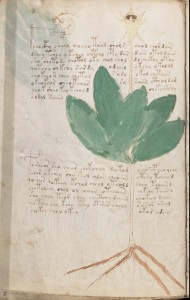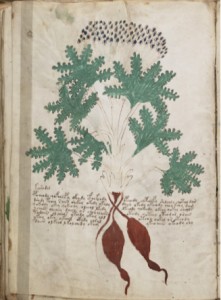Author Archives: J.K. Petersen
Large Plants – Folio 44r
Large Plants – Folio 43v
Large Plants – Folio 43r
Large Plants – Folio 42v
Plant 42v spans most of the page in the vertical direction. There are two text blocks crossing the upper and lower stalks. This page, even more than others, demonstrates how the integration of the text and the plant appear to be planned. One thing to note about the text is the final trailing characters on the bottom right. It’s rare for a VM “paragraph” to end on the right with a gap. This is seen only in a few places and the anomalous placement appears to be deliberate, since there’s room for the characters on the left of the stem.
Also note on this page the highly embellished first character on the top left. It is ornate in the manner of illuminations, but in a quirky individualistic style.
Plant Details
In terms of overall shape, this plant is similar to 5r, with a long stalk, a whorl of leaves, another stock and a flower head at the top.
The plant leaves are fairly large and painted a fairly consistent green, although the one on the left is a little lighter on the inside as though the pigment were diluted to last longer or to create a lighter shade. The margins appear to be relatively smooth, even if a bit irregular, rather than serrated.
The long roots that angle outward are reddish brown, and the flower head appears to have been filled in with the same brown ink used for the text.
The most distinctive feature is the shape of the single flower head which appears to include spurs. If the extra protrusions were sepals, they would probably have been painted a darker color, as was done in other VM illustrations. The cup-like center also stands out.
Prior Identification
Edith Sherwood has identified this plant as Aquilegia vulgaris (Culverwort). This doesn’t seem likely. Aquilegia vulgaris has palmate leaves and they are more thickly concentrated near the ground. In contrast, Plant 42v has elliptical leaves that are clustered some distance up the stem. More likely this is Trientalis europaea (Chickweed wintergreen), Trientalis borealis (Western star flower). One might consider one of the Epimediums, which have very distinctive spurs and a cupped center similar to this plant.
Epimedium and its Medicinal Reputation
Depending on the species, Epimedium spurs can be long or short, straight or curved, and the position of the petals or colored bracts can make it look almost like two sets of spurs. The center generally always has a cup-shaped group of blossoms and the pistil protrudes to various degrees, sometimes beyond the central “cup”, sometimes not.
Some of the Epidemiums (e.g., E. macranthum, E. sagittatum) have chemicals that promote hormonal effects in animals and sometimes humans. The plant is known as Horny Goat Weed and there are studies that suggest that goats who eat it have a higher sperm count. The plant is also included in a number of weight training products. Further, it is historically reputed to prevent breasts from growing too large when administered to women and is known by the name of barrenwort, which suggests that it may hinder conception and/or work as an abortifacient. It appears that the plant may have an effect similar to testosterone.
While the spurs make it tempting to identify this plant as a species of columbine, the overall shape and leaves don’t resemble columbine. It is closer to Epimedium, especially with the cupped flower and spurs. Columbine flowers are somewhat cupped, but the inner “cup” is not as rounded as Epimedium. Also, Columbine stamens tend to protrude more than Epimedium and would probably have been show in the VM drawing.
Epimedium isn’t a match, however. It typically has serrated or slightly spiny leaves and more often than not, the leaves are asymmetric, like begonia leaves. So while the flowers more closely resemble Epimedium than Aquilegia, the leaves and their arrangement do not. Epimedium flowers are numerous and, like Columbine, they tend to nod.
Halenia also has spider-like spurs, but the centers can be variable, sometimes cup-like, sometimes like the head of a bullet. The leaves come closer to Plant 42 than either Aquilegia or Epimedium.
ROUGH DRAFT TO BE CONTINUED
Halenia perrottetii Halenia umbellata
Posted by J. Petersen
Possible Alternatives
Large Plants – Folio 42r
Voynich Large Plants – Folio 41v
Folio 41v features a plant with tuberous roots that occupies most of the page. The text block covers seven lines that crosses the lower part of the plant, plus a single group of characters above the top left corner of the text.
The roots have been painted a solid brick red and are attached to the stem rather loosely, with strings, as though they might be rhizomes rather than roots or tubers. They have a double bump and a tendril coming from each end.
The leaves are complex, somewhat plamate, with lots of indentations that might be serrates, scallops, or perhaps ruffled scallops or lacinates. They tend to be concentrated at the base of the plant rather than branching up along a stalk.
The stems have been left uncolored and perhaps are lighter than the dark green leaves. They split, at the top, into many smaller stems with flowers or seedheads painted blue. The heads are small and numerous and might be umbellate.
Prior Identifications
It struck me immediately when I saw this, that it might be coriander. The complex leaves and umbellate seed heads look like the coriander I grew in my garden three years ago. I couldn’t remember, however, whether I pulled up the roots at the end of the year to see how they are shaped and I wasn’t certain whether coriander roots could have this yam-like appearance, so I looked around the Web.
It’s rare for me to agree with Edith Sherwood’s identifications, mainly because they seem to focus on one or two characteristics of the plant rather than the whole plant, but this time, she identified this as coriander and it seems possible. I still wanted confirmation, however, that coriander can have enlarged roots, and might have lighter-colored stems than leaves.
I looked at many different varieties of coriander, and couldn’t find any with ovate or dark reddish roots. They were all very parsnip-like, light-colored and carrot-shaped. A few were narrower and stringier. Since it’s my hunch that the VM plants are, for the most part, based on actual observations of plants, it seems unlikely the VM illustrator would make a mistake like this and put the wrong root on a commonly harvested food plant like coriander.
The Plant Hunt
Finding a root like this is not difficult. Ipomoae batatas, the sweet potato, comes immediately to mind. But… finding this kind of root with palmate leaves and a large umbel of small blossoms or seeds, can be a challenge. I discovered many possibilities.
Filipendula vulgaris has many small blossoms at the end of the stem, and similar roots to Plant 41v, sometimes with a smaller nodule at the end, but the leaves are very distinctive, with a small set of leaflets between each of the larger leaves. The VM illustrator probably would have included the leaflets, if this were Filipendula. Also, Filipendula isn’t palmate. The leaves are roughly elliptical and opposite, with a fern-like growth pattern.
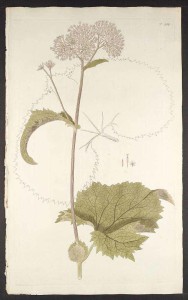 Cacalia, a member of the aster family, is quite a variable plant with almost any leaf shape, from delicate hairlike strands to pinnatisect, palmate, kidney-shaped or heart-shaped leaves, depending on the species. Illustrated here is Cacalia tomentosa from an 18th century herbal. In common with Plant 41v, Cacalia has very erect clusters of umbels and the roots or rhizomes (side-growing underground runners) can be rounded or tuberous and fairly large. Leaves are typically serrated. Cacaliopsis nardosmia has palmate leaves that would be challenging to draw but the umbel clusters are not as numerous as Plant 41v and it’s a west coast plant that wouldn’t have been known to Europe in the 15th century.
Cacalia, a member of the aster family, is quite a variable plant with almost any leaf shape, from delicate hairlike strands to pinnatisect, palmate, kidney-shaped or heart-shaped leaves, depending on the species. Illustrated here is Cacalia tomentosa from an 18th century herbal. In common with Plant 41v, Cacalia has very erect clusters of umbels and the roots or rhizomes (side-growing underground runners) can be rounded or tuberous and fairly large. Leaves are typically serrated. Cacaliopsis nardosmia has palmate leaves that would be challenging to draw but the umbel clusters are not as numerous as Plant 41v and it’s a west coast plant that wouldn’t have been known to Europe in the 15th century.
Parsley (Petroselinum) tends to branch more evenly than Plant 41v but parsnip can sometimes have more rounded tubers and palmate leaves that tend to concentrate at the base. However, parsnip tubers are typically light, not dark.
I didn’t want to assume the umbellate seedlike shapes at the top of Plant 41v were, in fact umbels—the stems leading to the flowerheads are quite long and not as parasol-like as one might expect. Somewhere in the back of my mind, I could remember a weed with a similar shape—one that rattles in the fall, but don’t know if I ever knew its name, which makes it hard to find it on the Net. I also considered that the thick seedhead (if indeed those are seeds rather than tiny flower heads) might represent multiple umbels that are simply hard for an amateur illustrator to draw.
Celeriac, a form of celery, can have large and quite variable roots, ranging from a pale color to a dark yellow, almost orange, but most of the time, the color of the root is light and it’s very knobby, unlike VM 41v, which is more smooth than rough. Celery seeds can be eaten, and thus might be represented as the numerous seed heads shown in VM 41v. Celeriac should probably be considered, but the dark red color of the Plant 41v roots invites us to keep looking.
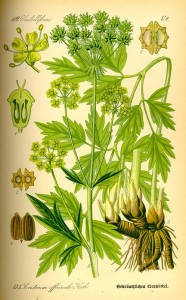 Levisticum officinale, commonly known as lovage (left) is sometimes known as “Love Parsley” and resembles table parsley in many ways. It has trifolate serrated leaves that look rather palmate, umbellate seedheads that are more vertical than some, seeds that are harvested as a spice, and large, thick, dark roots. The roots are rougher and not as rounded as Plant 41v and the stems tend to branch more evenly than the VM picture, but Levisticum should probably be considered as a possibility.
Levisticum officinale, commonly known as lovage (left) is sometimes known as “Love Parsley” and resembles table parsley in many ways. It has trifolate serrated leaves that look rather palmate, umbellate seedheads that are more vertical than some, seeds that are harvested as a spice, and large, thick, dark roots. The roots are rougher and not as rounded as Plant 41v and the stems tend to branch more evenly than the VM picture, but Levisticum should probably be considered as a possibility.
Carum carvii (Caroway) has fairly upright umbels, distinctive seeds that are used in cooking and baking, frondlike feathery leaves that might look somewhat palmate in an inexpert drawing, and fairly dark thick tap roots. The roots are not as rounded as 41v, and the leaves don’t really match.
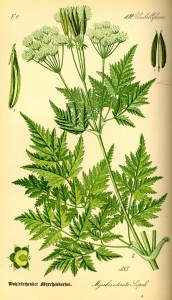 Another plant similar to Levisticum and Carum is Myrrhis ( left), known as cicely or chervil. It has umbellate flowerheads that tend to be a little longer and more vertical than some, the roots are large, dark, and sometimes rounded, and the brown seeds tend to stand up. This may be related to the weedy plant I’ve encountered on some of my hikes. The seeds are rather distinctive. One would be very tempted to say Plant 41v is some species of Myrrhis, but Myrrhis leaves are more frondlike than palmate, and larger than 41v. It’s probably a good contender, but may not be a match.
Another plant similar to Levisticum and Carum is Myrrhis ( left), known as cicely or chervil. It has umbellate flowerheads that tend to be a little longer and more vertical than some, the roots are large, dark, and sometimes rounded, and the brown seeds tend to stand up. This may be related to the weedy plant I’ve encountered on some of my hikes. The seeds are rather distinctive. One would be very tempted to say Plant 41v is some species of Myrrhis, but Myrrhis leaves are more frondlike than palmate, and larger than 41v. It’s probably a good contender, but may not be a match.
Crambe maritima (Sea Kale) has palmate, very ruffled leaves that would be challenging for the VM illustrator to draw, along with many round seedheads on vertical stems. It might be a tempting choice, the roots are thickened and dark, but they are not rounded and the leaves are rather large, not small or medium-sized as in Plant 41v.
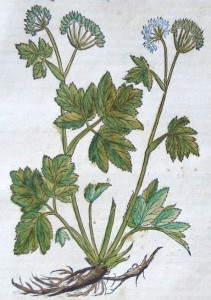 Astrantia major, Masterwort, an attractive and much-cultivated ornamental, poisonous plant (and traditional medicinal plant) has traits in common with Plant 41v, including serrated palmate leaves, umbel-shaped flower heads, and somewhat thick darker roots. They’re not as ovate as the Plant 41v roots, but they are closer in shape and coloration than Coriandrum.
Astrantia major, Masterwort, an attractive and much-cultivated ornamental, poisonous plant (and traditional medicinal plant) has traits in common with Plant 41v, including serrated palmate leaves, umbel-shaped flower heads, and somewhat thick darker roots. They’re not as ovate as the Plant 41v roots, but they are closer in shape and coloration than Coriandrum.
There is a South American plant that almost fits the bill. Arracacia, Peruvian carrot. It has somewhat ovate roots that cluster and come in many colors. the leaves are serrated odd-pinnate and look somewhat palmate, and the umbels have many distinctive seeds. The leaves are concentrated at the base, rather than branching, similar to VM 41v. The stems can vary from light green to a fairly deep red. One might say it was the best match so far. Arracacia is in the family Apiaceae.
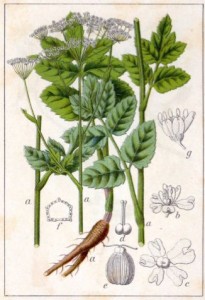 Pimpinella (salad burnet) has serrated, odd pinnate leaves that might be drawn as palmate. The small round seeds are on umbels, the root tends to be a fairly large tap root, and the plant is used medicinally, and as food. However, the root, while ranging from light to medium dark, tends to be more carrot-like than ovate.
Pimpinella (salad burnet) has serrated, odd pinnate leaves that might be drawn as palmate. The small round seeds are on umbels, the root tends to be a fairly large tap root, and the plant is used medicinally, and as food. However, the root, while ranging from light to medium dark, tends to be more carrot-like than ovate.
There are many plants with umbels, small seedheads, thickened roots, and palmate, or palmate-in-the-eyes-of-an inexpert-illustrator leaves, and there is one more worth mentioning. Conopodium majus is a plant with an edible root known as earth chestnut, or pignut. It has odd pinnate, palmate leaves, umbellate flowers, and the underground “chestnut” tends to be brownish-red and somewhat ovate. The leaves are concentrated at the base. The lower part of the stem can be light in color, almost white. The leaves are frondlike and so not a good match for the Plant 41v leaves, but in other respects, it bears consideration.
Summary
It’s difficult to make a definitive identification of this plant, with so many species having umbellate flowers and large roots. It’s probably best to leave the final determination of Plant 41v until more is known about the content of the text.
J.K. Petersen

